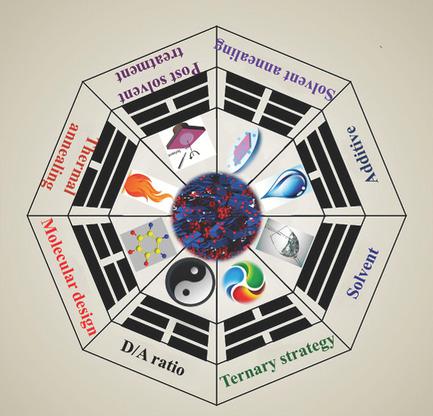当前位置:
X-MOL 学术
›
Adv. Energy Mater.
›
论文详情
Our official English website, www.x-mol.net, welcomes your
feedback! (Note: you will need to create a separate account there.)
Morphology Control in Organic Solar Cells
Advanced Energy Materials ( IF 24.4 ) Pub Date : 2018-03-13 , DOI: 10.1002/aenm.201703147 Fuwen Zhao 1, 2 , Chunru Wang 2 , Xiaowei Zhan 1
Advanced Energy Materials ( IF 24.4 ) Pub Date : 2018-03-13 , DOI: 10.1002/aenm.201703147 Fuwen Zhao 1, 2 , Chunru Wang 2 , Xiaowei Zhan 1
Affiliation

|
Organic solar cells (OSCs) can directly convert the sunlight into electrical energy and present some advantages, such as low cost, light weight, flexibility, semitransparency, and roll‐to‐roll large‐area fabrication. Due to the short diffusion length of exciton (≈10 nm) in organic semiconductor materials, the ideal nanoscale phase separation in the active layer is one of the crucial factors for achieving efficient exciton dissociation and charge transport. The morphology of the active layer is mainly determined by the nature of donors and acceptors (e.g., solubility, crystallinity, and miscibility), the film processing, the device configuration, and so on. In general, it is very hard to obtain ideal morphology in the as‐cast films. Therefore, it is usually essential to take measures to achieve the active layer with good molecular stacking, proper domain size, high domain purity, and suitable vertical phase separation. In this review, recent developments in morphology control and morphology characterization are summarized and analyzed. This review might help the community to decipher active layer morphology at multiple length scales and to achieve ideal morphology toward high‐performance OSCs.
中文翻译:

有机太阳能电池的形态控制
有机太阳能电池(OSC)可以将太阳光直接转化为电能,并具有一些优势,例如成本低,重量轻,柔韧性,半透明性以及卷对卷大面积制造。由于激子在有机半导体材料中的扩散长度很短(约10 nm),因此活性层中理想的纳米级相分离是实现有效激子离解和电荷传输的关键因素之一。活性层的形态主要取决于施主和受主的性质(例如,溶解度,结晶度和可混溶性),薄膜加工,器件结构等。通常,很难在铸态膜中获得理想的形貌。因此,通常必须采取措施以实现具有良好分子堆叠的活性层,适当的畴尺寸,高的畴纯度和合适的垂直相分离。在这篇综述中,对形态学控制和形态学表征的最新进展进行了总结和分析。这项审查可能会帮助社区在多个长度尺度上破译活性层形态,并实现针对高性能OSC的理想形态。
更新日期:2018-03-13
中文翻译:

有机太阳能电池的形态控制
有机太阳能电池(OSC)可以将太阳光直接转化为电能,并具有一些优势,例如成本低,重量轻,柔韧性,半透明性以及卷对卷大面积制造。由于激子在有机半导体材料中的扩散长度很短(约10 nm),因此活性层中理想的纳米级相分离是实现有效激子离解和电荷传输的关键因素之一。活性层的形态主要取决于施主和受主的性质(例如,溶解度,结晶度和可混溶性),薄膜加工,器件结构等。通常,很难在铸态膜中获得理想的形貌。因此,通常必须采取措施以实现具有良好分子堆叠的活性层,适当的畴尺寸,高的畴纯度和合适的垂直相分离。在这篇综述中,对形态学控制和形态学表征的最新进展进行了总结和分析。这项审查可能会帮助社区在多个长度尺度上破译活性层形态,并实现针对高性能OSC的理想形态。











































 京公网安备 11010802027423号
京公网安备 11010802027423号